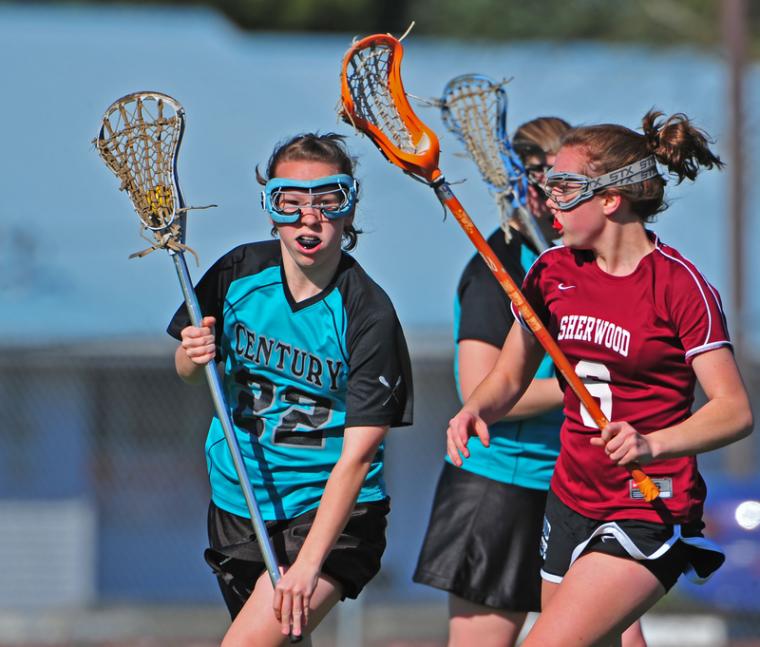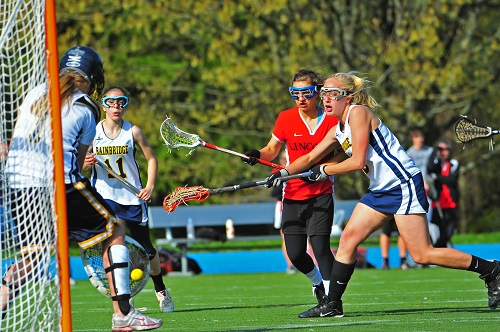

The rules they might be a’changin’.
Beginning in the 2022-23 season, the National Federation of State High School Associations (NFHS), in strengthening its relationship with USA Lacrosse, is expected to take a greater role in the rules writing process.
And that, of course, brings up the million-dollar question: Will protective headgear be mandated for girls?
It’s hardly a new issue, although it certainly does not stretch all the way back to the Native Americans who originated the game. Most recently, in 2019, it came to the fore when a report produced by researchers in the Department of Orthopedics at the New York University Langone Health showed headgear was effective at lowering the rate of head or facial injury and concussions in women's lacrosse. Additionally, mandated headgear use was also shown to lower the rate of injury to body locations other than the head or face during practice.
When COVID stopped all sports programs in their tracks – including, of course, team sports like lacrosse – the issue was set aside. Now, however, it is moving back under the microscope.
According to an announcement published by NFHS, NFHS and USA Lacrosse have signed an agreement that affirms the commitment of both organizations to strengthen the working relationship that has been in place for more than 20 years. The agreement, focused on athlete safety, rules development, developing and promoting resources, and recruiting and retaining coaches and officials, will align both NFHS high school rules committees and the USA Lacrosse youth rules committees to establish consistency in the rules-writing process.
The NFHS announcement notes, “In the area of rules development, the composition of the NFHS Girls Lacrosse Rules Committee will be altered, beginning with the 2022-23 season, to mirror the NFHS Boys Lacrosse Rules Committee. In both cases, USA Lacrosse will have a representative on the NFHS committees, and the NFHS will have representation on the USA Lacrosse Women’s and Men’s Game Youth Rules Subcommittees.”
This may open the door to addressing the ongoing concerns regarding concussion prevention in the girls’ side of the sport – although there are no formal statements.
“The health and safety of our student-athletes will always be a priority in the rules writing process as risk minimization is always considered during the rules writing process,” Lindsey M. Atkinson, CIC, RAA, Director of Sports and Communications Associate, and the NFHS’ liaison to the Girls Lacrosse Rules Committee, told SDM. “This year, the committee will meet June 21-23 virtually to discuss rules changes for the 2022 season. We will have reports from both the NFHS Sports Medicine Advisory Committee (SMAC) and USA Lacrosse’s Center for Sports Science and its Sports Science & Safety Committee. This information informs any committee decision regarding equipment and rules that impact the risk of injury to the student-athlete. Headgear continues to be an item of discussion for both the NFHS SMAC and the girls lacrosse rules committee. Both groups are staying abreast of all studies currently being conducted and past study outcomes on the use of headgear in states like Florida [Editor’s note: In 2014, the Florida High School Athletic Association made a groundbreaking decision to mandate soft headgear for girls’ lacrosse players.] Any rules changes that come out of the June Girls Lacrosse Rules Committee Meeting will be available to the public by Mid-July.”
In other words: wait and see.
Some other programs – though they are in the minority – have chosen to institute head protection mandates for their girls’ and women’s teams.
In 2017, Brown University became the first NCAA Division I women’s lacrosse program to require helmets for all players. That same spring, female lacrosse players for high schools on Long Island in New York were given the option to wear standardized lacrosse-specific helmets, but most coaches left the decision to actually wear them up to the individual players, according to Newsday.com. A handful of other schools followed suit.
In 2015, ASTM created a standard for women’s lacrosse helmets – but those helmets weren’t required, which meant that most manufacturing campaigns never gained traction. There was significant pushback from purists, who said such requirements would ruin the women’s version of the game, which relies on strategy and speed, rather than on contact. However, there has been a growing school of thought that the game is undergoing a sea change on the women’s side, becoming more aggressive with the migration of coaches from boys’ and men’s lacrosse programs.
There are already some helmets on the market for girls, including models like this. However, one option for head protection, that could strike the middle ground between those adamantly opposed to head protection and those lobbying for it, might be the mandating of soft headgear, similar to that required of Florida's high school girls' lacrosse players.
The NFHS and USA Lacrosse meetings are expected to cover not just game rules but the development and promotion of lacrosse educational programming to support lacrosse coaches and officials.
“We really appreciate the longstanding relationship we’ve had with the NFHS in working to create the best possible experience for high school athletes,” said Ann Kitt Carpenetti, Vice President for Lacrosse Operations for USA Lacrosse. “This agreement is another positive step forward, both in helping to maintain consistency in the rules for youth and high school players, and in developing critical educational resources for coaches and officials. We’re excited about the opportunities in front of us.”
It will be interesting to see whether the consistency in rules also applies to headgear.

